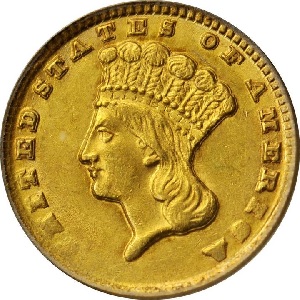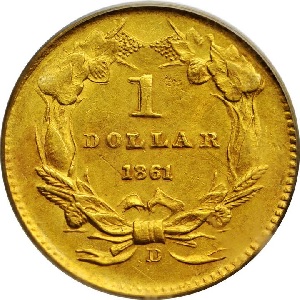1861-D Type 3 Gold Dollar
The election of Abraham Lincoln as the 16th president of the United States in November 1860 prompted a wave of southern states to secede from the Union, beginning with South Carolina on December 20.(1)
On January 7, 1861, two pairs of gold dollar dies arrived at the Dahlonega Mint in Georgia from Philadelphia, but were not put into service right away. Less than two weeks later, Georgia became the fifth state to break away.(2)
On April 8, just four days prior to the onset of the Civil War at Fort Sumter, Confederate forces took control of the Dahlonega Mint. The following month, the Rebels began minting gold coins from federal dies, using the small amount of bullion leftover in the facility.
An unknown number of 1861-D Gold Dollars, estimated to be 1,000 to 1,500 pieces, were coined under the auspices of the Confederacy. After the meager supply of gold bullion was exhausted, no more coins were issued. As it turned out, those were the last Dahlonega Mint coins the world would ever see.
The production quality of the 1861-D gold dollar had serious shortcomings. Apparently, after the change in management, at least some of the Mint personnel abandoned their posts, leaving inexperienced operators at the helm. The resultant coins were weakly struck from poorly prepped planchets.
The typical 1861-D displays shoddy lettering on the lower half of the obverse and softness on the reverse denticles. The fact that a worn obverse die from 1860 contributed to the problem.
There are three types of gold dollars. They are called:(3)
- Type 1 Coronet (a.k.a. Liberty Head) of 1849-1854
- Type 2 Indian Princess, Small Head of 1854-1856
- Type 3 Indian Princess, Large Head of 1856-1889
The 1861-D is the rarest Dahlonega gold dollar of all three types. Only about 75 examples are believed to exist today.(4)
Although its scarcity by itself attracts collectors, it is of incredible importance to history buffs, for it is the only coin ever made whose entire mintage was struck by the Confederate States of America.
Fascinating Fact: In 1873, the Dahlonega Mint was repurposed as an agricultural school. Tragically, the building burned to the ground in 1878. The following year, a new edifice was built upon the Mint’s granite foundation and is today called Price Memorial Hall, an administrative building on the University of North Georgia campus. For generations, historians lamented the fact that no full view photographs of the Dahlonega Mint building were known to exist. This all changed in October 1997, with the discovery of an authentic photo of the Dahlonega Mint building, taken circa 1877. The 120-year-old photo had been hiding in a file called "Old Photographs", in the office of the university president.(5)
Because of its extreme rarity and significant historical connections, the 1861-D Type 3 Gold Dollar is one of the most coveted coins in American numismatics. Coin collectors understand that with ownership of the 1861-D Gold Dollar, one comes face to face with a tangible participant that “was there” in the earliest days of the American Civil War.
| Estimated survivors in all grades: 75 ?
The survivor estimate from PCGS represents an average of one or more experts' opinions as to how many examples survive of a particular coin in all grades. Survival estimates include coins that are raw, certified by PCGS, and certified by other grading services. Learn more at PCGS. |
| PCGS Rarity Scale: 8.2 ?
The 'PCGS CoinFacts Rarity Scale' assesses the relative rarity of all U.S. coins, based on estimated surviving examples. The scale runs from 1.0 to 10.0. The higher the number, the rarer the coin.
Learn more at PCGS. |
| Click HERE to check for availability on eBay** |
Preview of eBay selection (the 1861-D gold dollar is rarely seen on eBay, as Civil War buffs gobble them up quickly):
 |
 |
| Trendline Avg = 9.47 | CLASSIC RARITY |
Historic Value Trend Charts:
| Last updated 7-8-24 | Return to Key Date Coin List | |
| Compare to Common Date Coin of Same Type | ||
|
|
||
| Download Charts to Your Computer | ||
Sources
1. Todd, Lewis P. and Curti, Merle. Rise of the American Nation, 3rd ed. New York, NY: Harcourt Brace Jovanovich, Inc., 1972.
2. Stack's Bowers Galleries. 1861-D Gold Dollar. Nov 2016 Auction.
3. Yeoman, R.S. and Garrett, Jeff, et al. A Guide Book of United States Coins, 75th ed. Pelham, AL: Whitman Publishing, 2021.
4. PCGS. 1861-D G$1 (Regular Strike).
5. Head, Sylvia Gaily and Etheridge, Elizabeth W. Neighborhood Mint: Dahlonega in the Age of Jackson. Dahlonega, Georgia: Gold Rush Gallery, 2000.
**Many very fine coin dealers sell on eBay. At any point in time, there may be over one million search results for United States coins. This includes quite a few of the recommendations on our Key Date Coin List.
If you’re thinking about purchasing a rare coin, eBay is certainly worth a look. For your convenience, the links from this site to eBay are coded to bring up only coins certified by PCGS and NGC.
As is always, always the case, never buy a valuable coin from a seller whose trustworthiness cannot be verified. Learn more about this at our chapter Best Places to Buy Coins, which also has a section on doing business on eBay.
In the interest of full disclosure, Rare Coins 101 receives a small commission anytime someone connects to eBay from this site and purchases something.
Coin images by Stack's Bowers Galleries.


